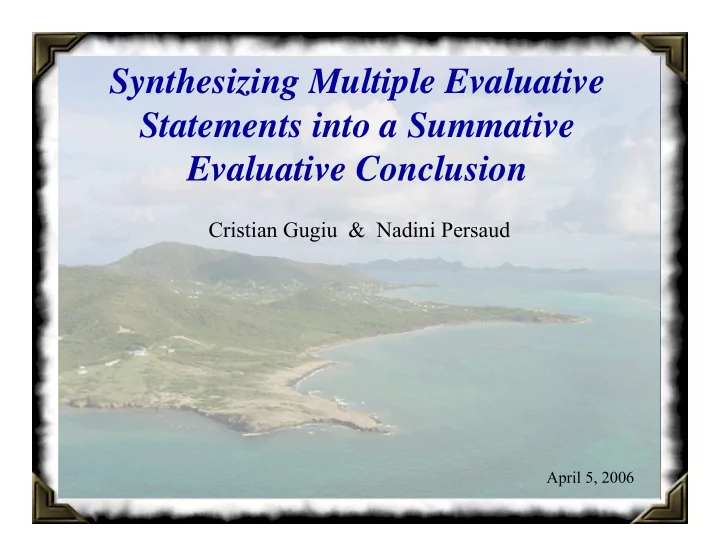

Synthesizing Multiple Evaluative Statements into a Summative Evaluative Conclusion Cristian Gugiu & Nadini Persaud April 5, 2006
The ABC Project � The purpose of the evaluation � Determine the merit, worth, and significance of the ABC College. � The evaluation was commissioned by the principal of the College. Timeframe � Evaluation activities started in January 2005 and continue into the present. Close to 2000 hours have been invested by the co-principal investigators. � All work has been completed pro bono.
Evaluative Framework � Value-driven evaluation � Five key features that distinguish between evaluation and research. � Values � Standards � Meaningful significance � Data synthesis � Summative confidence � Evaluation approaches � Collaborative evaluation � Goal-free evaluation � Needs assessment � Summative evaluation
Methodology � Data sources � Eight surveys were administered to � 291 Students (response rate 100%) � 28 Instructors (17 lecturers and 11 tutors, response rate 60%) � 2 Administrators (response rate 100%) � 7 Librarians (response rate 100%) � 3 Office staff (response rate 100%) � 4 Janitors (response rate 100%) � 5 Security guards (response rate 100%) � 29 Key stakeholders � Records (financial records, student records, exam results, legislative, newspapers) � Interviews with key informants � Site visit � The Internet
Identifying relevant values � Values � “Evaluative statements consist of fact and value claims intertwined” (House & Howe, 1999). � Needs assessment and analysis of qualitative data are an excellent source for identifying relevant values. � Student Survey � Analyzing qualitative data � Development of a relational database � Development of a qualitative coding scheme � Rating the importance of values � In order to develop a scoring rubric that reflects the values of the stakeholders, it is important to gather data � Values Survey
Obtaining appropriate standards � Standards � Standards refer to the level of performance that demarks acceptable and unacceptable (or excellent and less than excellent) performance for a value. � Three types of standards � Minimum bars � High bars � Holistic bars � Setting appropriate bars � Standards Survey
Analyzing your data � Quantifying qualitative data � Our 8 surveys generated a total of 1,197 statements from the open-ended questions. � These responses were then coded into a total of 2,212 categories. 68% Students, 16% Instructors, 5% Librarians, 4% Security guards,3% Principal, 2% Office staff, and 2% Janitors. � Calculate inter-rater reliability � For binary data, this means a phi coefficient or an interclass correlation. � Model type (I, II, III) and ICC � We calculated ICCs for Model 1. Our correlations rarely fell below 0.70.
Comparing performance to standards � Determining success and failure � One cannot determine whether the evaluand has “passed” or “failed” by simply comparing means. Consider the following example.
Comparing performance to standards � Standard error of the mean � The SE m is an estimate of the population mean that would be observed if data were repeatedly sampled from a population and means were calculated for each of the samples taken. � Obviously, one cannot repeatedly sample the entire population. Fortunately the SE m can be estimated by the formula σ 2 PQ SE m = = SE m N N
Comparing performance to standards � Asymmetric Confidence Intervals � There is no reason to expect that CIs should be symmetric and when dealing with proportions, they are not (except for when the proportion (p) = 0.50). � Asymmetric CIs can be calculated using the following formula provided by Hays (1994).
Comparing performance to standards � Finite Population Correction factor � The variance of the mean must be adjusted whenever one samples from a finite population where your Sample size N is 5% or more of the total population size T. � The correction factor (T-N)/T is applied to the variance component in your model. So, in the case of the asymmetric CI it looks like this ⎛ ⎞ − 2 2 ⎛ ⎞ N z T N PQ z ⎜ ⎟ + ± + ⎜ ⎟ P z ⎜ ⎟ + 2 2 2 ⎝ ⎠ 4 N z N T N N ⎝ ⎠
Comparing performance to standards � Accounting for inter-rater (un)reliability � Although Nadini and I were able to attain fairly high inter-rater reliability, the unreliability within the data, will nevertheless, cause our CIs to expand. The question is by how much? � Unfortunately, I could not locate a formula in the literature. However, I decided to write my own based onto principles. 1. The CIs should expand as a result of “adding” more uncertainty. 2. The CI should be unaffected when ρ = 1. 3. Likewise, as ρ approaches Zero, the CI should expand toward ± ∞ (or % 100 in the case of proportions). The CI is a function of σ 2 and ρ . More specifically, it is 4. proportional to σ 2 and ρ . Therefore, I believe the Var( σ 2 / ρ ) = σ 2 / ρ .
Creating a composite measure � Accounting for variance � Whenever a composite measure is created the variance is affected. Because we are interested knowing the standard error of the mean, we need to know how to handle the variance. � Case 1: Independent terms ( ) σ + σ = σ + σ Var 1 2 1 2 � Case 2: Dependent terms ( ) σ + σ = σ + σ + ρ σ σ 2 Var 1 2 1 2 12 1 2
Putting it all together � Summative Conclusions for ABC Summative Conclusions � The case for Summative Confidence
Synthesizing Multiple Evaluative Statements into a Summative Evaluative Conclusion Cristian Gugiu & Nadini Persaud April 5, 2006
Recommend
More recommend